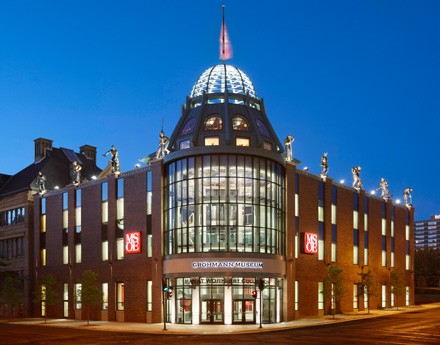Grohmann Museum
Introduction
Text-to-speech Audio
Although schools of engineering aren't the typical sites of an art museum, the Grohmann Museum is not a typical art museum. Instead, with a focus on artwork which shows the evolution of human work, the industrial paintings, scenes of machinery, and images of other engineering feats fit perfectly within the Milwaukee School of Engineering. In fact, the artwork becomes a chance for visitors to explore the engineering and human work milestones, which have occurred throughout history and which bring students of engineering to their school today.
Images
The Grohmann Museum opened in 2007 and is the most comprehensive museum in the world dedicated to human work.

Backstory and Context
Text-to-speech Audio
In 2001, Dr. Eckhart Grohmann donated the "Man at Work" collection, along with additional funds to open a museum, to the Milwaukee School of Engineering. The result today is the three-story Grohmann Museum.
The museum attempts to show the evolution of human work, starting first with people on their farms. The artwork then transitions to work of tradesmen, such as chemists and cobblers. Later works show the result of industrialization, with a view of factories and machines. Visitors are given a "first-hand" glance at these transitions through the artists that viewed them.
The museum is, however, without some controversy. At the time of the Grohmann Museum's opening in 2007, a little-known German artist named Erich Merker was the most represented artist in the collection. Merker was an extremely prolific artist who primarily painted industrial scenes during the first half of the 20th century.
However, Merker's art gained its greatest fame in its propaganda use for the Third Reich. Merker's salary and popularity rose entirely with his ability to produce paintings that showed the "successes" and "beauty" of Hitler's revolution. As the museum began to unravel the history of this artist, the museum responded by further research. In fact, the only biography ever written on the artist is sold from the Grohmann Museum.
Art historians, engineers, and political historians may all take interest in Merker's strange place in the museum. His presence in a museum that seeks to celebrate the "evolution" of human work, at the very least, soberly reminds visitors of the other possibilities in human work--possibilities where humans work together to harm others. Today Merker's work continues to be displayed along with many other lesser- and better-known artists, who displayed humanity at work. Visitors can explore all the paintings and consider for themselves the role of artists in industry and politics.
The museum attempts to show the evolution of human work, starting first with people on their farms. The artwork then transitions to work of tradesmen, such as chemists and cobblers. Later works show the result of industrialization, with a view of factories and machines. Visitors are given a "first-hand" glance at these transitions through the artists that viewed them.
The museum is, however, without some controversy. At the time of the Grohmann Museum's opening in 2007, a little-known German artist named Erich Merker was the most represented artist in the collection. Merker was an extremely prolific artist who primarily painted industrial scenes during the first half of the 20th century.
However, Merker's art gained its greatest fame in its propaganda use for the Third Reich. Merker's salary and popularity rose entirely with his ability to produce paintings that showed the "successes" and "beauty" of Hitler's revolution. As the museum began to unravel the history of this artist, the museum responded by further research. In fact, the only biography ever written on the artist is sold from the Grohmann Museum.
Art historians, engineers, and political historians may all take interest in Merker's strange place in the museum. His presence in a museum that seeks to celebrate the "evolution" of human work, at the very least, soberly reminds visitors of the other possibilities in human work--possibilities where humans work together to harm others. Today Merker's work continues to be displayed along with many other lesser- and better-known artists, who displayed humanity at work. Visitors can explore all the paintings and consider for themselves the role of artists in industry and politics.
Sources
"About the Museum." Grohmann Museum. Accessed April 14, 2015. https://www.msoe.edu/grohmann-museum/the-collection.
Schumacher, Mary Louise. "Grohmann Museum addresses life of controversial Nazi-era artist Erich Mercker." Milwaukee Journal Sentinel. December 5, 2015. http://archive.jsonline.com/entertainment/arts/biography-begins-but-doesnt-complete-portrait-of-nazi...
Schumacher, Mary Louise. "Grohmann Museum addresses life of controversial Nazi-era artist Erich Mercker." Milwaukee Journal Sentinel. December 5, 2015. http://archive.jsonline.com/entertainment/arts/biography-begins-but-doesnt-complete-portrait-of-nazi...
